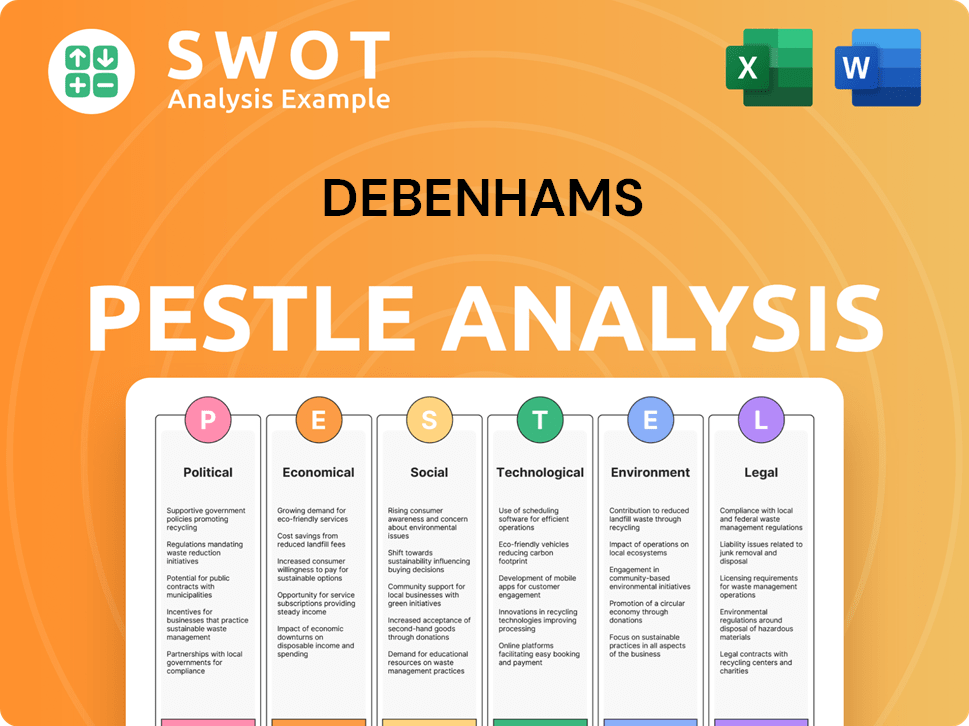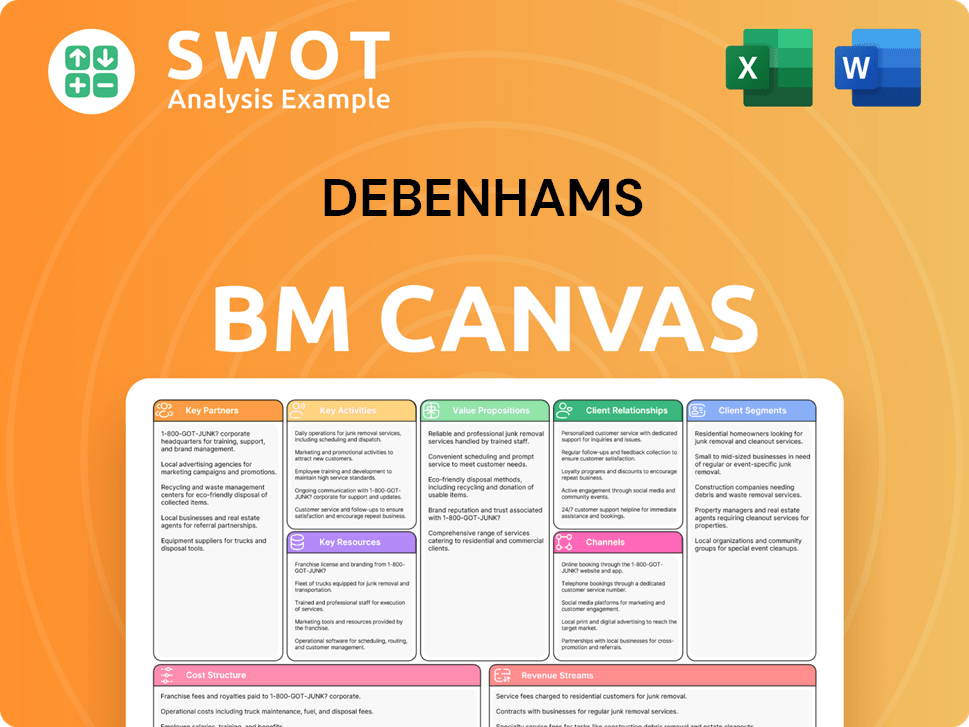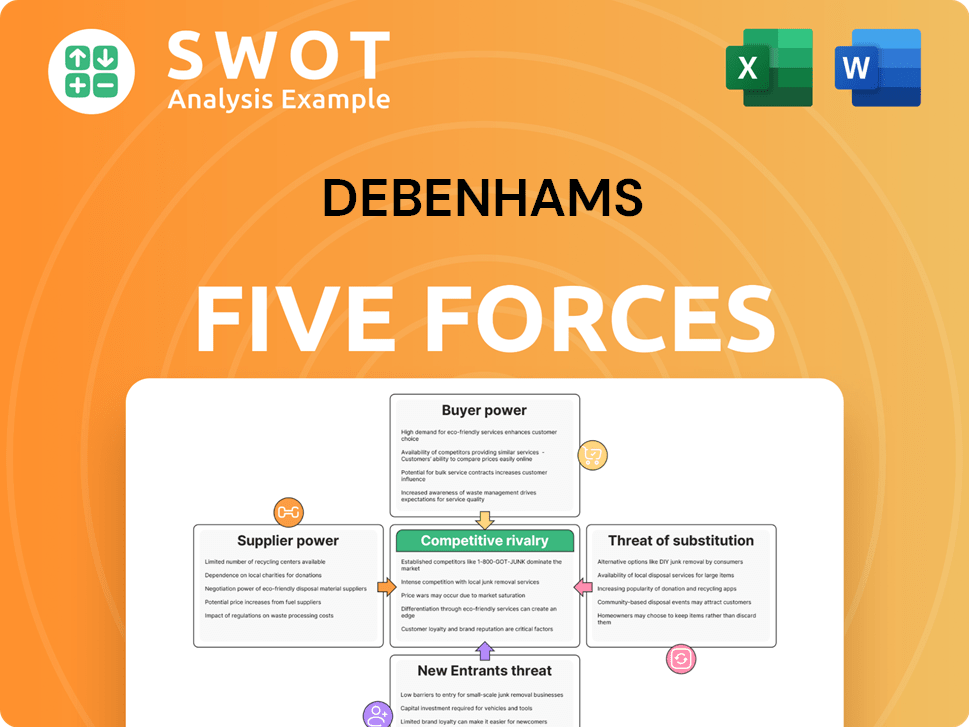Debenhams Bundle
Can Debenhams' Story Teach Us About Retail's Future?
Debenhams, once a British retail icon, has undergone a remarkable transformation. From its department store dominance to its current online-only presence under the Boohoo Group, Debenhams' journey offers a fascinating case study. Understanding Debenhams SWOT Analysis and its operational shifts is key to navigating the evolving retail landscape.

This exploration of Debenhams delves into its history, business model, and the strategic decisions that shaped its evolution. We'll examine how Debenhams, once a high-street giant, adapted to the digital age. Analyzing Debenhams' structure and operations provides valuable insights into how established brands can survive and thrive in the face of disruption. Understanding how Debenhams works, including its revenue strategies, is crucial for anyone interested in the future of retail, including Debenhams' competitors analysis.
What Are the Key Operations Driving Debenhams’s Success?
The current iteration of Debenhams operates exclusively online, a significant shift from its history as a department store chain. This Debenhams business model focuses on digital retail, offering fashion, beauty, and homeware products. The core value proposition revolves around providing a broad selection of goods through an accessible online platform, leveraging the established brand recognition of Debenhams.
The operational model is now deeply integrated with the Boohoo Group's e-commerce infrastructure. This includes technology for online sales, digital marketing, and logistics. The absence of physical stores allows for greater agility and a focus on digital customer engagement, aiming to offer convenience and competitive pricing. The Debenhams operations are streamlined through this digital-first approach.
The company sources products from various brands, including third-party labels and potentially private-label goods. The supply chain is managed through direct supplier relationships and Boohoo's distribution networks. Customer service is primarily handled through digital channels. If you want to know more about the company's past, you can read the Brief History of Debenhams.
Debenhams sources and sells products online, focusing on fashion, beauty, and homeware. It utilizes Boohoo's e-commerce infrastructure for sales, marketing, and logistics. The operational model is streamlined, without the overhead of physical stores, allowing for efficiency and digital customer engagement.
The company's structure is centered around its online platform, supported by Boohoo's technology and distribution networks. Customer service is primarily digital. This structure allows for a wide product assortment and a focus on digital customer experience. The shift to online-only operations marks a significant change in the Debenhams structure.
The Debenhams retail strategy is entirely digital, utilizing Boohoo's e-commerce capabilities. This strategy involves offering a wide range of products, leveraging digital marketing, and providing customer service through online channels. The focus is on convenience, competitive pricing, and a broad product selection.
Debenhams is currently owned by the Boohoo Group. The acquisition by Boohoo marked a significant transition, moving the brand from a department store model to an online-only retail platform. This ownership structure has reshaped the company's operations and strategic direction.
Debenhams leverages Boohoo's e-commerce infrastructure for online sales and logistics, streamlining operations. The absence of physical stores allows for a focus on digital customer engagement and potentially more competitive pricing. The supply chain is managed through direct supplier relationships and Boohoo's distribution networks.
- Online-only retail model.
- Integration with Boohoo's e-commerce platform.
- Digital customer service.
- Focus on fashion, beauty, and homeware.
Debenhams SWOT Analysis
- Complete SWOT Breakdown
- Fully Customizable
- Editable in Excel & Word
- Professional Formatting
- Investor-Ready Format

How Does Debenhams Make Money?
The current Growth Strategy of Debenhams focuses on online sales as its primary revenue stream. This shift from a multi-channel approach to a purely online model has significantly altered its revenue mix. The business model now relies almost entirely on digital transactions.
Debenhams generates revenue mainly through direct product sales via its e-commerce platform. This encompasses a wide range of products, including clothing, beauty items, and home goods. These offerings include both third-party brands and any private-label products sold under the Debenhams name.
Monetization strategies involve competitive pricing, targeted digital marketing, and a user-friendly online shopping experience. Promotional offers, seasonal sales, and potential loyalty programs are used to encourage repeat purchases. As part of the Boohoo Group, specific disaggregated revenue figures for Debenhams are not reported independently.
The
Debenhams business model
centers on maximizing online sales volume through several key strategies. These include competitive pricing to attract customers, and targeted digital marketing campaigns to increase visibility. The focus is on providing a seamless online shopping experience to drive sales.- E-commerce Sales: Virtually 100% of revenue comes from online product sales.
- Pricing and Promotions: Competitive pricing and promotional offers are used to drive sales.
- Digital Marketing: Targeted digital marketing campaigns are essential for attracting customers.
- User Experience: A user-friendly online shopping experience is crucial for converting visitors into buyers.
Debenhams PESTLE Analysis
- Covers All 6 PESTLE Categories
- No Research Needed – Save Hours of Work
- Built by Experts, Trusted by Consultants
- Instant Download, Ready to Use
- 100% Editable, Fully Customizable

Which Strategic Decisions Have Shaped Debenhams’s Business Model?
The most significant turning point for Debenhams occurred in January 2021, when the Boohoo Group acquired it after the company entered administration. This acquisition marked a pivotal shift from a traditional department store model to an online-only retail brand. Before this, Debenhams faced significant challenges, including declining foot traffic, intense competition from online retailers, and substantial debt burdens. This ultimately led to the company's liquidation.
The strategic response to these challenges involved Boohoo's acquisition of the Debenhams brand and website. This move preserved the brand's name while eliminating the costly physical infrastructure. This allowed Boohoo to broaden its market reach beyond its core fast-fashion demographic to include beauty, homeware, and a wider fashion offering, capitalizing on Debenhams' established brand recognition. Understanding Owners & Shareholders of Debenhams provides further context on the ownership transition.
Currently, Debenhams' competitive advantage stems from its strong brand recognition, built over centuries, now combined with Boohoo's agile e-commerce platform and operational expertise. This setup enables Debenhams to compete effectively in the online retail space. The company continues to adapt to new trends by integrating with Boohoo's data-driven approach to merchandising and marketing, aiming to remain relevant in the rapidly evolving digital retail landscape.
The acquisition by Boohoo Group in January 2021 was a critical milestone, transforming Debenhams into an online-only retailer. Before this, the company struggled with declining sales and high operational costs. The shift allowed Debenhams to leverage Boohoo's e-commerce expertise and expand its product offerings.
The primary strategic move was the transition to an online-only model, eliminating physical stores and reducing overhead. This move enabled Debenhams to focus on e-commerce, leveraging Boohoo's platform. The focus is now on expanding product categories and enhancing the online shopping experience.
Debenhams' competitive edge is its strong brand recognition combined with Boohoo's e-commerce capabilities. The brand offers a wide range of products without the high costs associated with physical stores. They are also using data-driven merchandising and marketing to stay relevant.
Debenhams operates as an online retailer, selling various products through its website. The company leverages Boohoo's infrastructure for e-commerce, including logistics, marketing, and customer service. This structure allows Debenhams to adapt to changing consumer preferences and market trends.
The Debenhams business model is now centered on e-commerce, utilizing the existing brand equity to drive online sales. This model involves sourcing products from various suppliers and offering them through the Debenhams website. Marketing and customer service are key components.
- Online Retail: Debenhams functions as an online retailer, selling a wide range of products through its website.
- Supply Chain: The company sources products from various suppliers.
- Marketing: Debenhams employs digital marketing strategies to attract customers.
- Customer Service: Customer service is provided online to handle inquiries and support sales.
Debenhams Business Model Canvas
- Complete 9-Block Business Model Canvas
- Effortlessly Communicate Your Business Strategy
- Investor-Ready BMC Format
- 100% Editable and Customizable
- Clear and Structured Layout

How Is Debenhams Positioning Itself for Continued Success?
In its current online-only form, the Debenhams business model operates within the highly competitive e-commerce sector, focusing on fashion, beauty, and homeware. The company leverages the broader market position of the Boohoo Group, its parent company. The competitive landscape includes major online retailers and pure-play fashion e-tailers.
Key risks for Debenhams include intense competition in the online retail space, evolving consumer preferences, potential supply chain disruptions, and the need to continuously innovate. Economic downturns affecting consumer spending also pose a risk. The future outlook for Debenhams is tied to the overall success of the Boohoo Group.
Debenhams competes within the e-commerce sector, specializing in fashion, beauty, and homeware. The company benefits from the Boohoo Group's overall market presence. Customer loyalty now depends on its online experience, product offerings, and competitive pricing.
Debenhams faces intense competition in online retail. Consumer preferences for sustainability and ethical sourcing are evolving. Supply chain disruptions and the need for digital innovation are ongoing challenges. Economic downturns impacting consumer spending pose additional risks.
The future of Debenhams as an online entity is linked to the Boohoo Group's success. Strategic initiatives likely involve optimizing its online presence and expanding its product assortment. The company aims to offer a diverse range of products online.
Debenhams makes money by offering a diverse range of products online. It maintains competitive pricing and adapts to the dynamic demands of the e-commerce market. The company focuses on online shopping and customer service.
The Boohoo Group guides Debenhams' strategic initiatives. These include optimizing its online presence and expanding its product range. The aim is to leverage synergies with other brands within the group.
- Focus on online platform optimization.
- Expansion of the product assortment.
- Integration with other Boohoo Group brands.
- Competitive pricing and marketing strategies.
Debenhams Porter's Five Forces Analysis
- Covers All 5 Competitive Forces in Detail
- Structured for Consultants, Students, and Founders
- 100% Editable in Microsoft Word & Excel
- Instant Digital Download – Use Immediately
- Compatible with Mac & PC – Fully Unlocked

Related Blogs
- What are Mission Vision & Core Values of Debenhams Company?
- What is Competitive Landscape of Debenhams Company?
- What is Growth Strategy and Future Prospects of Debenhams Company?
- What is Sales and Marketing Strategy of Debenhams Company?
- What is Brief History of Debenhams Company?
- Who Owns Debenhams Company?
- What is Customer Demographics and Target Market of Debenhams Company?
Disclaimer
All information, articles, and product details provided on this website are for general informational and educational purposes only. We do not claim any ownership over, nor do we intend to infringe upon, any trademarks, copyrights, logos, brand names, or other intellectual property mentioned or depicted on this site. Such intellectual property remains the property of its respective owners, and any references here are made solely for identification or informational purposes, without implying any affiliation, endorsement, or partnership.
We make no representations or warranties, express or implied, regarding the accuracy, completeness, or suitability of any content or products presented. Nothing on this website should be construed as legal, tax, investment, financial, medical, or other professional advice. In addition, no part of this site—including articles or product references—constitutes a solicitation, recommendation, endorsement, advertisement, or offer to buy or sell any securities, franchises, or other financial instruments, particularly in jurisdictions where such activity would be unlawful.
All content is of a general nature and may not address the specific circumstances of any individual or entity. It is not a substitute for professional advice or services. Any actions you take based on the information provided here are strictly at your own risk. You accept full responsibility for any decisions or outcomes arising from your use of this website and agree to release us from any liability in connection with your use of, or reliance upon, the content or products found herein.